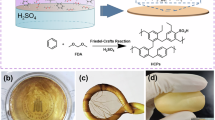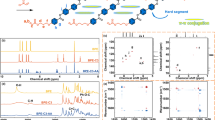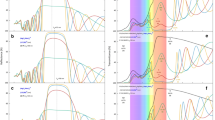Abstract
Herein, I review the fabrication of new optical composites that exhibit color changes without dyes or pigments covering the whole visible region in response to temperature via changes in both the diffraction properties and the wavelength dispersion of their refractive indices. These systems, which are composed of porous polymer membranes and thermosensitive liquids, display bright coloration caused by the Christiansen effect because the wavelength dispersion of the polymer membranes and the liquids intersect in the visible region. The thermally tunable coloration of the porous polymer membranes containing thermosensitive liquid arises from the coincidence at one wavelength of the dispersion curves of the porous polymer membranes and the thermosensitive liquid portions and depends on the composition and temperature of the thermosensitive liquid.
Similar content being viewed by others
Log in or create a free account to read this content
Gain free access to this article, as well as selected content from this journal and more on nature.com
or
References
Teshima, M., Seki, T., Kawano, R., Takeuchi, S., Yoshioka, S. & Takeoka, Y. Preparation of structurally colored, monodisperse spherical assemblies composed of black and white colloidal particles using a micro-flow-focusing device. J. Mater. Chem. C 3, 769–777 (2015).
Ohtsuka, Y., Seki, T. & Takeoka, Y. Thermally tunable hydrogels displaying angle-independent structural colors. Angew. Chem. Int. Ed. Engl. 54, 15368–15373 (2015).
Yoshioka, S. & Takeoka, Y. Production of colourful pigments consisting of amorphous arrays of silica particles. Chemphyschem. 15, 2209–2215 (2014).
Hirashima, R., Seki, T., Katagiri, K., Akuzawa, Y., Torimotoa, T. & Takeoka, Y. Light-induced saturation change in the angle-independent structural coloration of colloidal amorphous arrays. J. Mater. Chem. C 2, 344–348 (2014).
Takeoka, Y., Yoshioka, S., Teshima, M., Takano, A., Harun-Ur-Rashid, M. & Seki, T. Structurally coloured secondary particles composed of black and white colloidal particles. Sci. Rep. 3, 2371 (2013).
Takeoka, Y., Yoshioka, S., Takano, A., Arai, S., Nueangnoraj, K. & Nishihara, H. Production of colored pigments with amorphous arrays of black and white colloidal particles. Angew. Chem. Int. Ed. Engl. 52, 7261–7265 (2013).
Takeoka, Y. Stimuli-responsive opals: colloidal crystals and colloidal amorphous arrays for use in functional structurally colored materials. J. Mater. Chem. C 1, 6059–6074 (2013).
Takeoka, Y. Angle-independent structural coloured amorphous arrays. J. Mater. Chem. 22, 23299–23309 (2012).
Harun-Ur-Rashid, M., Bin Imran, A., Seki, T., Ishi, M., Nakamura, H. & Takeoka, Y. Angle-independent structural color in colloidal amorphous arrays. Chemphyschem. 11, 579–583 (2010).
Takeoka, Y., Honda, M., Seki, T., Ishii, M. & Nakamura, H. Structural colored liquid membrane without angle dependence. Acs Appl. Mater. Interfaces 1, 982–986 (2009).
Gotoh, Y., Suzuki, H., Kumano, N., Seki, T., Katagiri, K. & Takeoka, Y. An amorphous array of poly(N-isopropylacrylamide) brush-coated silica particles for thermally tunable angle-independent photonic band gap materials. N. J. Chem. 36, 2171–2175 (2012).
Takeoka, Y. Fusion materials for biomimetic structurally colored materials. Polym. J. 47, 106–113 (2015).
Prum, R. O., Torres, R. H., Williamson, S. & Dyck, J. Coherent light scattering by blue feather barbs. Nature 396, 28–29 (1998).
Dufresne, E. R., Noh, H., Saranathan, V., Mochrie, S. G. J., Cao, H. & Prum, R. O. Self-assembly of amorphous biophotonic nanostructures by phase separation. Soft Matter 5, 1792–1795 (2009).
Noh, H., Liew, S. F., Saranathan, V., Mochrie, S. G. J., Prum, R. O., Dufresne, E. R. & Cao, H. How noniridescent colors are generated by quasi-ordered structures of bird feathers. Adv. Mater. 22, 2871–2880 (2010).
Shawkey, M. D. & Hill, G. E. Significance of a basal melanin layer to production of non-iridescent structural plumage color: evidence from an amelanotic Steller’s jay (Cyanocitta stelleri). J. Exp. Biol. 209, 1245–1250 (2006).
Kumano, N., Seki, T., Ishii, M., Nakamura, H. & Takeoka, Y. Tunable Angle-Independent Structural Color from a Phase-Separated Porous Gel. Angew. Chem. Int. Ed. Engl. 50, 4012–4015 (2011).
Kumano, N., Seki, T., Ishii, M., Nakamura, H., Umemura, T. & Takeoka, Y. Multicolor polymer-dispersed liquid crystals. Adv. Mater. 23, 884–888 (2011).
Christiansen, C. Untersuchungen über die optischen Eigenschaften von fein verteilten Körpern. Ann. Phys. Chem. 24, 439–446 (1885).
Raman, C. V. The theory of the Christiansen experiment. Proc. Ind. Acad. Sci. 29, 381–390 (1949).
Cauchy, M. On a new formula for solving the problem of interpolation in a manner applicable to physical investigations. Philos. Mag. Ser. 8, 459–468 (1836).
Edo, S., Okoshi, K., Kang, S., Tokita, M., Kaneko, T. & Watanabe, J. Unusual swelling of HPC in toluene forming a microspherical domain structure that causes christiansen scattering coloration. Langmuir 26, 1743–1746 (2010).
Kato, T., Mizoshita, N. & Kishomoto, K. Functional liquid-crystalline assemblies: self-organized soft materials. Angew. Chem. Int. Ed. Engl. 45, 38–68 (2006).
Kato, T., Hirai, Y., Nakaso, S. & Moriyama, M. Liquid-crystalline physical gels. Chem. Soc. Rev. 36, 1857–1867 (2007).
Moriyama, M., Mizoshita, N. & Kato, T. Photopatterning of discotic liquid-crystalline gels. Polym. J. 36, 661–664 (2004).
Shishido, A. Rewritable holograms based on azobenzene-containing liquid-crystalline polymers. Polym. J. 42, 525–533 (2010).
Moriyama, M., Mizoshita, N., Yokota, T., Kishimoto, K. & Kato, T. Photoresponsive anisotropic soft solids: Liquid-crystalline physical gels based on a chiral photochromic gelator. Adv. Mater. 15, 1335–1338 (2003).
Ozaki, M., Shimoda, Y., Kasano, M. & Yoshino, K. Electric field tuning of the stop band in a liquid-crystal-infiltrated polymer inverse opal. Adv. Mater. 14, 514–518 (2002).
Kubo, S., Gu, Z. Z., Takahashi, K., Fujishima, A., Segawa, H. & Sato, O. Tunable photonic band gap crystals based on a liquid crystal-infiltrated inverse opal structure. J. Am. Chem. Soc. 126, 8314–8319 (2004).
Kubo, S., Gu, Z. Z., Takahashi, K., Ohko, Y., Sato, O. & Fujishima, A. Control of the optical band structure of liquid crystal infiltrated inverse opal by a photoinduced nematic-isotropic phase transition. J. Am. Chem. Soc. 124, 10950–10951 (2002).
Li, J., Wen, C. H., Gauza, S., Lu, R. B. & Wu, S. T. Refractive indices of liquid crystals for display applications. J. Disp. Technol. 1, 51–61 (2005).
Acknowledgements
This work was partially supported by a Grant-in-Aid for Scientific Research on Innovative Areas of ‘Fusion Materials: Creative Development of Materials and Exploration of Their Function through Molecular Control’ (No 2206) from the Ministry of Education, Culture, Sports, Science and Technology, Japan (MEXT).
Author information
Authors and Affiliations
Corresponding author
Ethics declarations
Competing interests
The author declares no conflict of interest.
Rights and permissions
About this article
Cite this article
Takeoka, Y. Angle-independent colored materials based on the Christiansen effect using phase-separated polymer membranes. Polym J 49, 301–308 (2017). https://doi.org/10.1038/pj.2016.117
Received:
Revised:
Accepted:
Published:
Issue date:
DOI: https://doi.org/10.1038/pj.2016.117
This article is cited by
-
Poly(lactic acid)/opal-methacryloylpropyltrimethoxysilane-polystyrene graft polymer composites: preparation, characterization, and performance
Iranian Polymer Journal (2020)
-
Artificial melanin particles: new building blocks for biomimetic structural coloration
Polymer Journal (2019)
-
Preparation of biobased wrinkled surfaces via lignification-mimetic reactions and drying: a new approach for developing surface wrinkling
Polymer Journal (2017)



